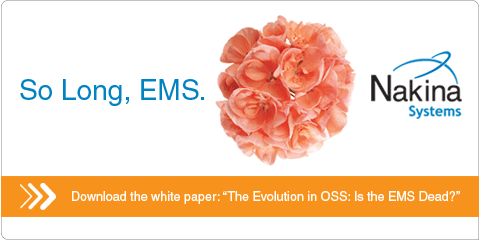|
|

article page | 1 | 2 | 3
I do not have space to go into all of the rationale for why existing systems will be overwhelmed by this issue of proactive response to QoS gradations, but listing a few major issues:
- Speed of required response (sub minute to sub second)
- Increases of scale associated with multiple kinds of threshold warnings and violations (being an order-of-magnitude multiplier on types of alarms)
- Integration of SLA definitions and other new OSS artifacts into existing systems and processes
- Embedded manual processes in linier work flow
I have long maintained that this requires a completely new architecture for OSS systems.
Alternatives: The TeleManagement Forum New Generations Operating Systems and Software (TMF NGOSS) has described how to build OSS systems which are reactive to
|
|
"So the question to be answered is not so much about IMS itself, but about the associated cost of complexity. " |
|

The maturity of web service standards now will let an application at an end customer location send a secure message to a service provider OSS system that indicates issues “as the customer will perceive them.” Organization for the Advancement of Structured Information Standards (OASIS) is providing standards where any web service application can communicate with any other web service application. These standards can be extended from e-business to e-business (B2B) into Pervasive Computing architectures – thereby delivering autonomic proactive QoS. Good news is that EJB application server companies are putting these facilities inside their products. Yet while existing applications can be retrofitted to intercommunicate with web service messages, the current state-of-the-art architecture is Service Oriented Architecture (SOA). This requires a rethinking of application design requirements from “solve all the business issues in an integrated package” to “provide one business service to any other authenticated service which needs it”.
|
|
|
|
|

events, that is, are “event driven.” NGOSS systems could adapt to provide autonomic responses to QoS issues arising from probes. Prosspero, the new alliance of OSS/J and the TMF NGOSS, will provide commercial, modernized approaches to adapt existing systems architectures, following traditional OSS functional component descriptions for “event driven” responses.
But first, service providers and customers must jointly agree to extend the scope of what is considered a problem – all the way to the user’s application system. This is foremost a business visualization issue and not a trivial one. Technically, this is what is embodied in Pervasive Computing. It is being solved by close cooperation of instrumented hardware & software, wide-area networks and distributed computing. Standards for this are being worked within the Global Grid Forum (GGF) which is merging with the Enterprise Grid Alliance (EGA)
|
|

Coming together: A convergence of architectural design is occurring among the TMF NGOSS, OASIS, W3C, GGF, and the Jini community around designs that have been catalyzed by the Internet 2 project. Basically, new services which manage both the network and the systems that are critical to the SOA are based on familiar internet middleware: Directories/registries, authentication services, etc. These converged architectures are just now arriving in products like the Systenet 2 SOA governance and lifecycle management platform.
Yet it is not always good, or possible, to build systems which work around and leave out human interactions. The pendulum should not be allowed simply to swing from totally manual to totally automated, since that inevitably will create a new set of problems, for which the pendulum will have to swing once again to the other extreme.
|
|
|
|




